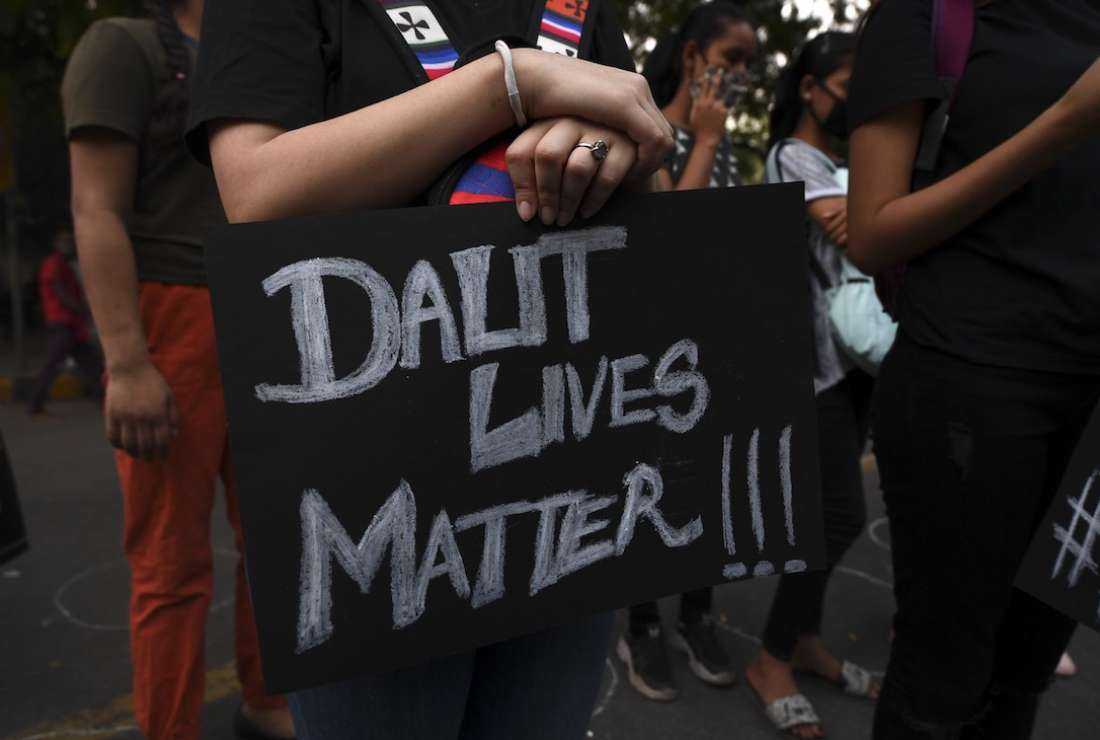The tradition of secrecy and confidentiality to hide the truth does not cut ice with an enlightened society

Protesters gather in New Delhi on Oct. 4, 2020, after the gang rape and murder of a 19-year-old Dalit woman. Dalit Archbishop Anthony Poola is to be made a cardinal in the August 2022 consistory. (Photo: AFP)
The elevation of Archbishop Antony Poola of Hyderabad, a Dalit, to the rank of cardinal was widely commented upon in India and internationally. Its significance, I think, goes beyond the Dalit issue.
Communication from local churches reaches the Roman Curia through the established channels of bishops, episcopal bodies, papal nuncios, and so on. The response also follows this institutional route — something very glaring in the process of bishops’ appointments.
To what extent could one credit these official channels for the appointment of a Dalit cardinal given their pattern of behavior and actions for several decades? Often, it would appear that the Dalit issue has been presented by non-Dalit bishops and episcopal bodies as a matter of casteism and causing division in the Church.
The standard biblical locus classicus the institutional channels have been using is, “There is neither Jew nor Greek, there is neither slave nor free, there is neither male nor female; for you are all one in Christ Jesus” (Gal. 3: 28). The Church’s administration is above caste and does not bother about whether a candidate is a Dalit or whichever caste he may belong to. Here ends the issue.
This is what I would call the Brahminic argument. Brahminism, for example, says that there is no caste because the divine spark dwells in everyone, and therefore everybody is equal. This idealism does not match the stark realities and experiences of exclusion based on purity and pollution.
What makes the straitlaced official channels of communication problematic is the fact that the picture they present to higher-ups is filtered, could often be seriously distorted, and is conditioned, inevitably, by personal views, ideological leanings, prejudices — open and unconscious — concerns of career advancement, and influenced not the least by the lure and “the love of money [which] is the root of all evils” (I Tim 6:10).
The persistent struggles of Dalit people and their doggedness in representing their plight have made a difference and undoubtedly led to the Vatican waking up
At the bottom, in the mode of hierarchical communication, there is the real danger that the lower echelons of authority fall in line with the expectations of the higher ones. The consequences could be very damaging and even disastrous.
The difference between the official communication channels and the actual reality was glaring in the recent statistics on Covid-19 infection and deaths. According to the World Health Organisation, there were an estimated 4.7 million deaths in India — 10 times more than the official figures!
Authorities hid information to make it appear as if everything was under control. But the barrage of official misinformation and disinformation was too fake to claim any credibility in a world and society of fast flow of information.
The traditional strategy of using secrecy and confidentiality to hide the truth and avoid being challenged has become a matter of yesteryear. They do not cut ice with an increasingly enlightened public in society and the Church.
If despite a long misunderstanding of what is at stake with the Dalit issue, and indeed even a lack of willingness to discuss it in depth, the fact that an appointment of a Dalit as cardinal has taken place is significant. It demonstrates that the Vatican has deployed other sources to assess the situation of the Dalits in India.
The persistent struggles of Dalit people and their doggedness in representing their plight have made a difference and undoubtedly led to the Vatican waking up. The Vatican thus became able to view the Dalit issue through a different lens, different from the one placed on them by the official channels.
The few Dalit bishops and many Dalit faithful have been presenting to the Secretariat of State and other Roman dicasteries such a large pool of information and analysis that the highest administration in the Church could no more be silent.
This marks a new turning point in the history of Catholicism in India — an honor for the Church in India, an encouragement for the Dalit people and an achievement for alternative sources of communication in the Church, all in one.
We could hope that the Christian faithful in India, in the spirit of synodality, will make ample use of the direct communication with the central administration of the Church
Today, the “hub and spoke” model of communication must give way to the “spoke and hub” model in the spirit of the synodal church that Pope Francis is urging us to transform into. In fact, the official channels must encourage rather than stifle these alternative communication channels.
To my knowledge, no canon law prohibits such a communication from the field directly to the central administration. On the contrary, the spirit of Can. 212 §2 encourages the faithful to express their needs and desires to the central administration, which assists the pope in his role as the universal pastor.
Moreover, the recent document on the reform of the Roman Curia by Pope Francis — Praedicate Evangelium — has once again made clear following Vatican II that the Roman Curia is at the service of the Church.
To go by the same document, increasingly, the various dicasteries of the Roman Curia will be headed not by cardinals but by baptized Catholics, men and women. This alternative source and mode of communication will be free of the shibboleths and paraphernalia with which the entrenched official bureaucratic communication surrounds itself.
We could hope that the Christian faithful in India, in the spirit of synodality, will make ample use of the direct communication with the central administration of the Church. It could slowly but steadily influence the policies and decisions, as the appointment of a Dalit cardinal has proved.
Sunlight, as they say, is the best disinfectant!
* Father Felix Wilfred is a Catholic theologian based in Chennai, India. He has been a member of the Vatican’s International Theological Commission and a visiting professor at several international universities. A former secretary of the theological advisory committee of the Federation of Asian Bishops’ Conferences (FABC), the 74-year-old priest was also president of the International Theological Review Concilium published in seven European language editions. The views expressed in this article are those of the author and do not necessarily reflect the official editorial position of UCA News.

